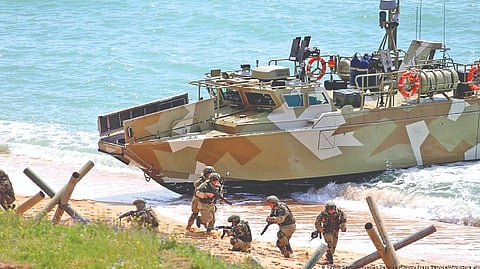

WASHINGTON: When Russia began amassing its troops along the border with Ukraine about a year ago, many Western experts and politicians believed Kyiv would fall within a few days of an invasion. This also seemed to be Russia’s assumption. But when Russian troops advanced to the outskirts of the capital in the first days of the war, they were halted by the Ukrainian army and forced to withdraw. Those miscalculations continue to reverberate to this day. Though Russian President Vladimir Putin has not directly admitted to it, in early December he seemed to be preparing his country for a long war.
Several expectations did not materialise after the February invasion. It was thought that Russia would quickly gain air sovereignty by eliminating both the Ukrainian Air Force and air defenses, an assumption that may have been based on previous observations in eastern Ukraine.
When war broke out in the eastern Donbas region in 2014, with Russia denying any involvement, Ukraine took heavy losses of planes and helicopters in the first few months, and opted not to use those that remained. The Ukrainian Air Force was virtually eliminated.
Things have gone quite differently in recent months, however. The February 28 announcement by Russian Defense Ministry that the country had claimed sovereignty over Ukraine’s entire airspace turned out to be false. While it remains true that the Russian Air Force is clearly superior in terms of size and technology, Ukraine still maintains intact aircraft and helicopters despite numerous missile attacks on military airports and combat operations on the front lines. Its air defenses are growing stronger, too.
Ukrainian sources have said Russia has lost hundreds of aircraft and helicopters since the war began. Though these claims cannot be independently confirmed, Western intelligence services also point to significant losses for the Russian Air Force, which is operating on a limited basis at the front lines and no longer venturing deep into Ukraine’s interior. Instead, Russia is using an increasing number of drones and missiles that are also being intercepted more and more effectively by Ukrainian air defenses. Kyiv owes much of this to continued Western aid.
Russia also clearly outmatches Ukraine at sea. In 2021, Moscow twice conducted training exercises in the annexed Crimea Peninsula, landing troops. The exercises raised fears that the Kremlin would launch an offensive in southern Ukraine and move toward Odesa, using warships to bring large troop formations and armored personnel carriers ashore. Not only has this not come to pass, experts are now skeptical that it will ever happen.
“Amphibious landings are very risky,” said Marc DeVore, a senior lecturer on international defense policy at the University of St. Andrews, adding that it requires a significant overmatch in capabilities. Russia has apparently been looking for landing opportunities but hasn’t found an “unprotected beach,” he said. While Russian troops managed to occupy the small and strategically important Snake Island southwest of Odesa after gathering warships offshore at the start of the invasion, Ukraine managed to drive them out with targeted artillery attacks in late June.
In fact, Russia’s Black Sea fleet has so far proved to be one of the biggest losers in the war. The flagship cruiser Moskva was damaged by Ukrainian missiles in April and later sank. A month earlier, the landing ship Saratov also sank after it was hit by a Ukrainian missile in the port of Berdyansk in the Sea of Azov.
Visit news.dtnext.in to explore our interactive epaper!
Download the DT Next app for more exciting features!
Click here for iOS
Click here for Android